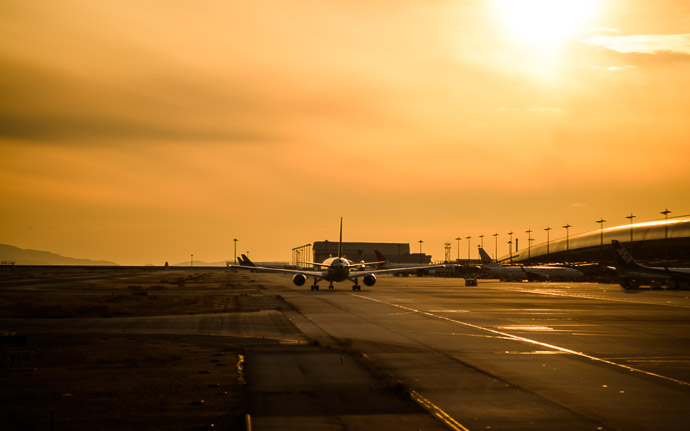
Nikon D4 + Voigtländer 125mm f/2.5 — 1/1600 sec, f/2.5, ISO 100 — map & image data — nearby photos
Right to the Gate
Home Sweet Home, arriving last night
at the Kansai International Airport (関西国際空港) near Osaka Japan
I'm finally back in Kyoto.
My blog posts about my transpacific trips are normally simple affairs, such as (for example) this Kyoto-to-Ohio post from 2007, but the return trip from my trip to Ohio this year has been quite the ordeal, covered so far with:
- Doh! Got to the Airport a Day Early to Find my Flight Delayed Four Days
- Finally Got My Return Flight Rescheduled
- Continuing Saga of My Return to Japan: Flight Canceled Again
- To No One’s Surprise, United Blames My Non-Weather Cancellations on Weather
- Halfway Home: Overnighting in San Francisco
The first four posts were of dread and gloom, though things looked decidedly better at the end. I'm very happy to report that the flight from San Francisco to Japan was the Best · Flight · Ever.
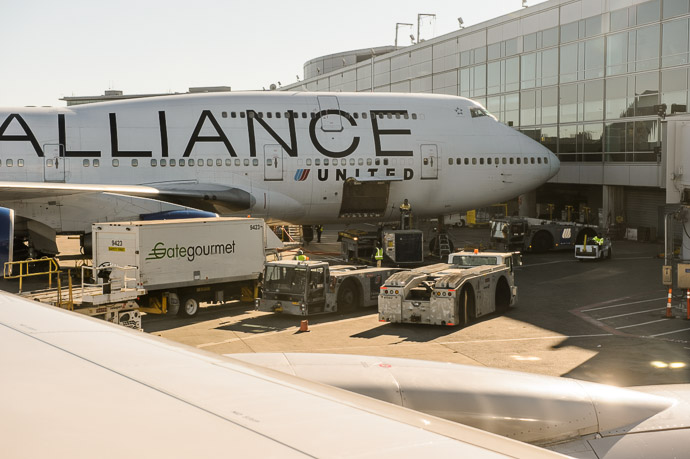
Nikon D4 + Nikkor 24-70mm f/2.8 @ 62mm — 1/200 sec, f/8, ISO 100 — map & image data — nearby photos
Pulling From the Gate
a 747-400 just in from Sydney at the gate next door
from my seat on UA885, San Francisco International Airport
That's the plane from Easing In on the previous post.
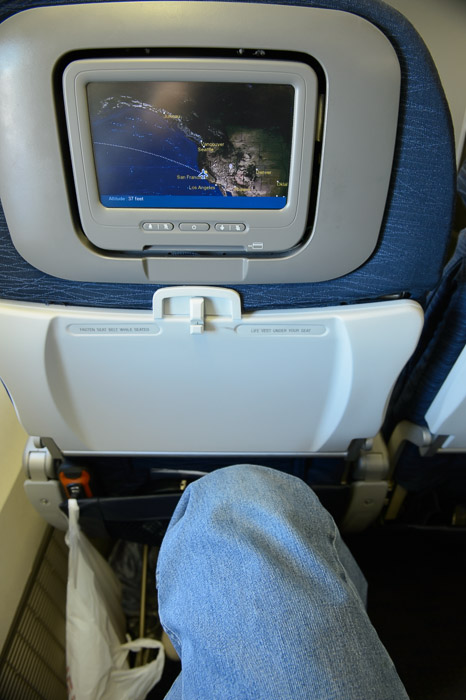
Nikon D4 + Nikkor 24-70mm f/2.8 @ 24mm — 1/50 sec, f/5.6, ISO 1600 — map & image data — nearby photos
Sitting with Crossed Legs!
not possible in economy class for someone 6'4"
The key to this flight being great was in how uncomfortable the flight the previous evening had been from Cleveland to San Francisco, and before that last month's flight from Tokyo. I'm sort of tall, so seats on public transport are usually uncomfortable, but my legs were particularly uncomfortable for the five-hour flight the previous day from Cleveland... I kept wanting to cross my legs to relieve the pressure where the edge of the seat hit the bottom of my legs, but I couldn't.
So, the first thing I did when I got to my hotel in San Francisco was upgrade my SFO→Osaka ticket to United's extra-legroom “Economy Plus”. It cost $155 for the single segment, but for a 12-hour flight I hoped that the extra three inches of legroom would be worth it.
As we'll see, combined with some luck, it turned out to be the best $155 I have ever spent.
(Mini rant: from what I can tell, “Economy Plus” is the recent name for what in decades past was simply called “Economy”; what's now called “Economy” should really be called “Economy Minus”.)
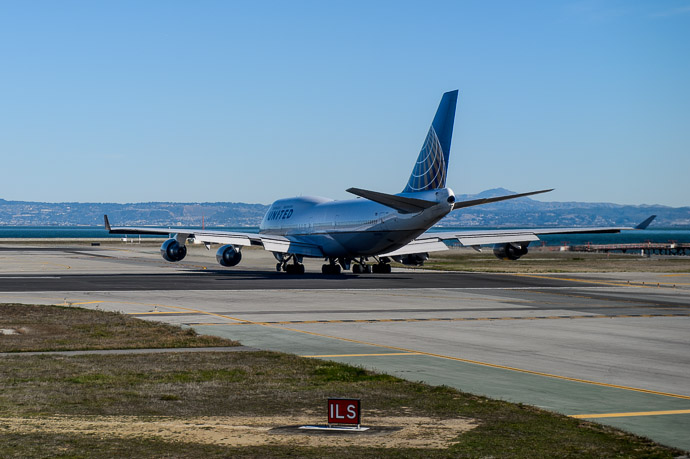
Nikon D4 + Nikkor 24-70mm f/2.8 @ 70mm — 1/500 sec, f/5.6, ISO 100 — map & image data — nearby photos
Next In Line
behind UA893 on its way to Incheon, Korea
We spent a few seconds shy of 20 minutes taxiing the 2.3 miles from the gate to the base of Runway 28L...
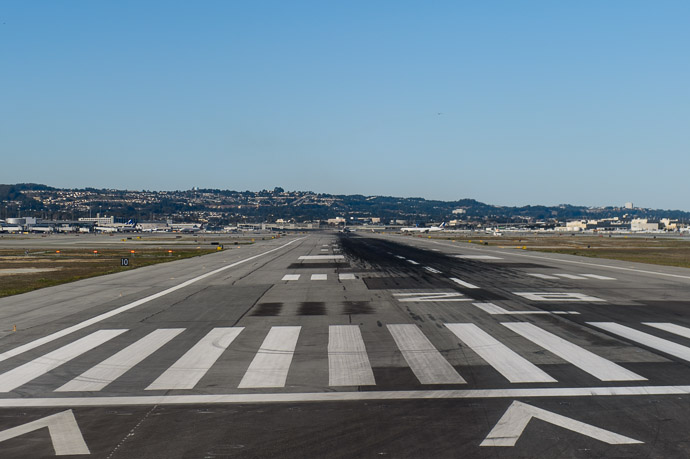
Nikon D4 + Nikkor 24-70mm f/2.8 @ 70mm — 1/2000 sec, f/2.8, ISO 100 — map & image data — nearby photos
SFO's Runway 28L
moments before we turned and used it
with a plane still landing on it a couple of miles distant
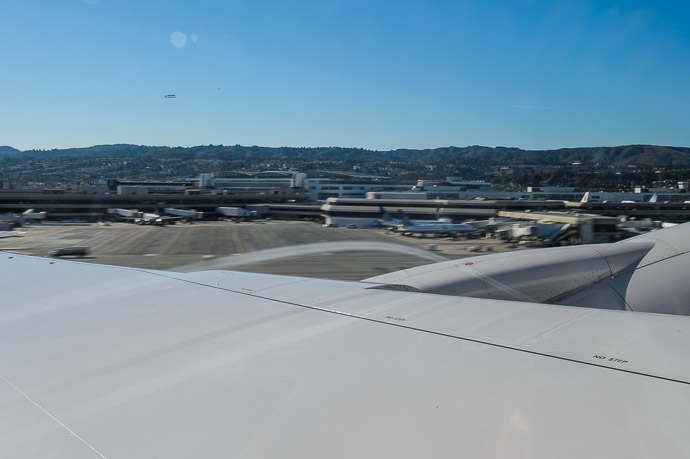
Nikon D4 + Nikkor 24-70mm f/2.8 @ 31mm — 1/40 sec, f/22, ISO 100 — map & image data — nearby photos
And We're Away
above the airport at 210 mph
The length of the flight can vary greatly depending on the winds and, perhaps even more importantly, whether the plane is routed directly to the runway at Osaka or made to fly 100 miles out of the way to come in from the other direction. I don't know why it's sometimes done that way, but for whatever reason my particular flight was, at 11h 50m, the longest it's been in a month, an hour and fifteen minutes longer than the recent quickest one.
But I didn't mind, because I had all the space in the world:
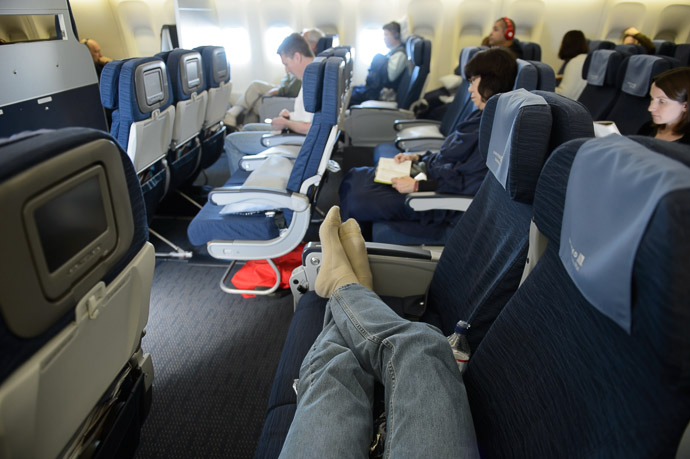
Nikon D4 + Nikkor 24-70mm f/2.8 @ 24mm — 1/50 sec, f/2.8, ISO 1250 — map & image data — nearby photos
Welcome to My Office
The “Economy Minus” section was jammed packed, but the “Economy Plus” section I'd paid extra to be in was more than half empty; like me, most people got three seats to themselves.
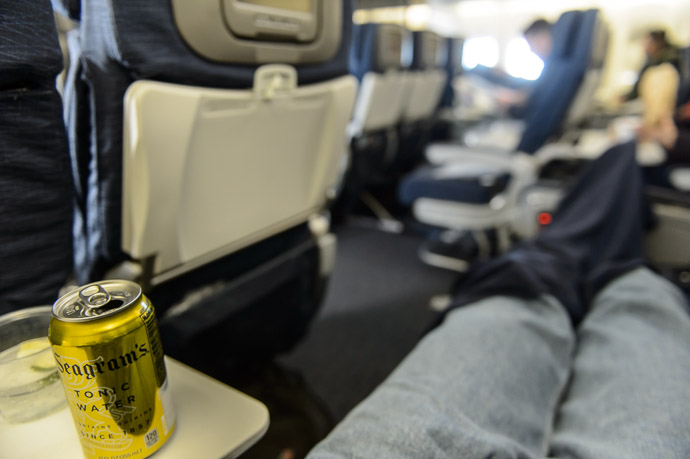
Nikon D4 + Nikkor 24-70mm f/2.8 @ 24mm — 1/50 sec, f/2.8, ISO 1250 — map & image data — nearby photos
Drink Service
Tonic and Lime
Alcohol stopped being free on domestic flights long ago, but remained free on international flights until very recently; this time they were charging $7 for a beer. It didn't bother me, though, because I stay away from alcohol anywhere around long flights for fear it makes jetlag worse, so I had my standard tonic and lime.
I watched a movie and ate dinner, after which I took a hefty dose of Ambien and curled up into a ball on my expanse of three seats, and slept about six or seven hours(!) This is exceedingly rare for me, so it was wonderful.
In light of the frost patterns I've posted recently, here's the frost pattern on the window an hour out of Osaka...

Nikon D4 + Voigtländer 125mm f/2.5 — 1/2500 sec, f/5.6, ISO 2000 — map & image data — nearby photos
Ice Crystals at 41,000 Feet
12½km up @ 564 km/h
( What on earth is that little hole for? )
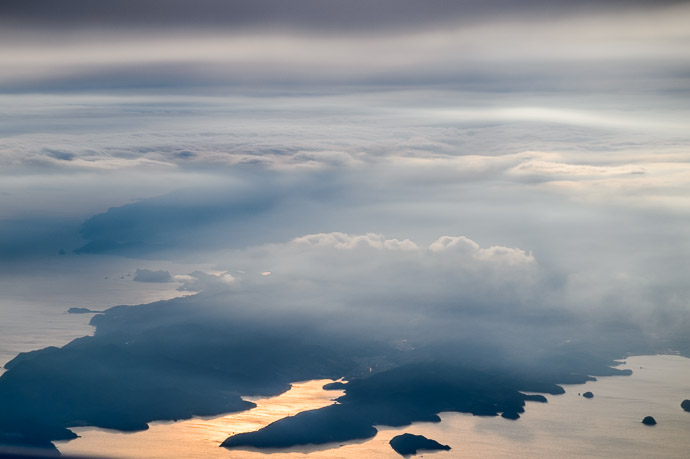
Nikon D4 + Voigtländer 125mm f/2.5 — 1/500 sec, f/4, ISO 100 — map & image data — nearby photos
Eastern Shikoku
from 3km up, 15 minutes before landing
I made great time once we landed... we pulled off the runway right into the gate. (The lead photo above is from my seat while we were pulling off the runway, and it really did look just that rich and orange.) There was literally no line at immigration, so I was through in seconds, but sadly, it took 15 minutes for my bag to arrive. Then on to the Haruka express train to Kyoto, where I had similarly nice seating...
Normally I'm a zombie at this stage in the trip, but I felt great, so I decided to catch up a bit by finally going through my photos from the Seifuso Villa. Therein lies a dozen posts if I can ever find the time to write them.
A taxi ride from Kyoto Station, and I was home at about 7pm to the wonderful cry of “Daddyyyyyyy” from Anthony.
I felt great and energetic until about 9pm when I suddenly got very tired; I mostly slept through the night, without Ambien(!). I've been sort of in a mild haze all day and have gotten nothing done except this blog post, but that's still better than my normal jetlag experience, which is normally described as “crushing”. We'll see how it goes.
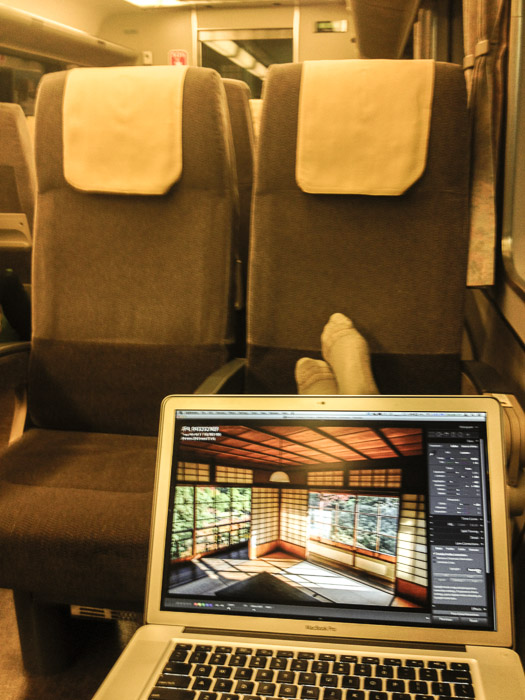
Welcome back 🙂
AFAIK the little hole is for pressure equalization.
And the reason why there’s an acrylic panel in front of the glass window is to avoid people from freezing their fingers 🙂
Thanks, that all makes sense. I figured the hole was for pressure equalization of some sort, but I didn’t know about the anti-frozen-fingers pane. I just wish I could remove the windows in flight, ’cause they get in the way of good pictures. —Jeffrey
Welcome back!
I know this all happened under special circumstances, but WOW why are there almost no people in the plane?? And most of them seem to be foreigners!
I’ve not been back home very often. In the 6 years I’ve been in Japan now, I’ve only gone back to my home country, Germany, three times.
I also went back this winter vacation, but the plane was completely full and mostly “filled with” Japanese people (as always). The few foreigners in there were tourists.
Anyways, glad to see you made it back safely. 😀
Nice picture of the ice crystals!
The little hole is about pressure equalization, but there’s a bit more to it than that.
The outer window is primary, the inner window is a failsafe, and both can take full pressure loads in flight: the little pinhole helps transfer routine (but minor) internal pressure changes to the primary window.
But if the outer window fails, the inner window will take the load, and the pinhole isn’t big enough to depressurize the plane (though I imagine it would be noisy).
There might be something about air circulation and condensation too, but I don’t know if that’s a real factor.
To expose my aviation geek a bit: the runway that is used depends on where the wind is coming from.
[geek mode on]
By flying into the wind on takeoffs and landings, airplanes get some “free” lift because there’s extra air that’s flowing over the wings. So if a plane can takeoff into a 10 knots (~15 km/h) wind, that’s ten knots that don’t have to be generated by the engines, and so less fuel is burned. Of course this mostly applies to takeoffs and landings, and cruising at 30,000+ feet wind is treated a bit differently.
Your flight landed at 2014-01-13 at 16:29 local (07:29 UTC/Zulu), so if you look up the old METeorological Aerodrome Report (METAR; read: “airport weather report”) that pilots and air traffic controllers get, you’ll see find:
http://www.eoas.fsu.edu/rawdata/metar/20140113/2014011307.metar
Which translates into RJBB (airport), thirteenth day of the month at 07:30Z, wind coming from 30 degrees at a speed of 10 knots, then a bunch of other stuff we’ll ignore. [1]
So given that the wind was coming from a north-easternly direction (30), it’s no surprise that the plane landed on a runway in that generally direction, which in the case of RJBB/KIX, would be their 14L or 14R runways. “14” in the runway number means that the runway has a rough magnetic bearing of 140 on the compass.
If the wind was coming from a south-westernly direction, planes would be landing with bearing of 300, on runways 30L or 30R.
[1] A good “METAR decoder” at: http://www.skystef.be/metar-decoder.htm
[geek mode off]
I understand about takeoff/landing into the wind. What I don’t understand is the need to go hundreds of miles out of the way in a wide sweeping arc to come in from that direction. I’ve seen it enough times at KIX (which doesn’t get a ton of traffic) to know that it can’t be just to adjust the spacing of the landings (like you’d see at ORD, for example). —Jeffrey
The wide berth is probably to avoid the takeoff/landing paths from Osaka and to not conflict with its airspace, which for the typical Class B of busy airports can extend out to in a radius of 30 nmi / 50 km, and up to 10,000 feet / 3,000 m. However, given that RJBB and RJBB are “only” 24 nmi / 44 km apart, it’s probably smaller than that. Given the relative closeness of the two airports, they’re probably stepping on each other’s toes when it comes to airspace:
https://en.wikipedia.org/wiki/Airspace_class
The airplanes and air traffic controllers (ATC) are following what are called STandard ARrival charts (STAR):
https://en.wikipedia.org/wiki/Standard_Terminal_Arrival_Route_%28STAR%29
And once they’re a bit closer to the airport, there are standardized procedures for each runway:
https://en.wikipedia.org/wiki/Approach_plate
Each of these is designed to take into account terrain and other airports in the area so that the flight paths and holding patterns of the various airports don’t get too close to each other. And “close” is a legally mandated distance–both vertically and horizontally–which while seemingly inefficient, was decided on over the decades from various experiences of close calls and mid-air collisions:
https://en.wikipedia.org/wiki/Separation_%28air_traffic_control%29
There are also some smaller airports in the area (Yao/RJOY; Kobe/RJBE) for some added fun, each of which most likely have an area of control, though smaller than the other two (probably Class C or D, which don’t extend as far):
http://www.ourairports.com/countries/JP/27/
So while it does look silly sitting as a passenger, the system generally works towards the efficiency and safety from an ATC point of view.
(And a correction to my earlier commend: RJBB has runways 06/24 L and R; RJOO is the one with 14/32 L and R.)
Thanks for the explanations, but it still doesn’t all add up. Sometimes we’ll come in directly on a straight-line vector from Tokyo (right over Yao and the Osaka city), but if landing the other way we’ll loop under the Ise penninsula 120km to the south. It’s as if it’s fine to overfly the 2nd most populated area of Japan, but not okay to overfly the essentially unpopulated thousands of square kilometers to the south. I’m sure there’s a reason; I just can’t figure it out. —Jeffrey
I am writing to tell you have much I enjoyed your blog posts and photos covering your recent trip to Ohio and back. Very enjoyable reading and photos of your son, niece, and the birds. I’ve been following your blog for about a year now so figured it was high time to give some feedback.
David
St. Louis, Missouri
USA
Outside of noise abatement restrictions, the population of an area doesn’t matter much to airplane routing. I’m in Toronto, the largest city in Canada, and the standard arrival path for Pearson International (CYYZ, the top airport in Canada) when the wind is blowing from the west is over downtown with planes flying at about 6000′ / 2000m, then making a 180 to point to the runways. When they’re at that height, you can’t really hear them on a reasonable busy street.
Doing a quick search, the JP Ministry of Land, Infrastructure and Transport has some information on the organization of Japanese airspace:
http://www.mlit.go.jp/koku/15_hf_000020.html
Couldn’t find any recent detailed charts though. Depending on how much you really want to know, you can ask around:
http://www.airliners.net/aviation-forums/